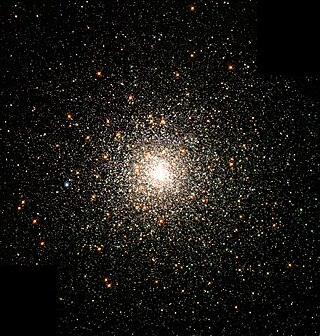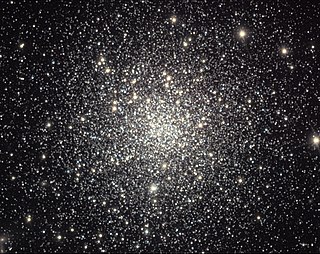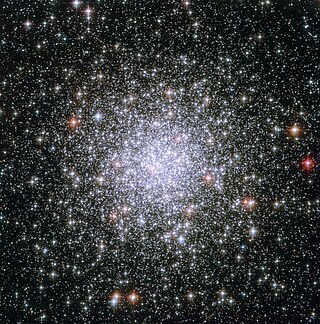
Messier 14 is a globular cluster of stars in the constellation Ophiuchus. It was discovered by Charles Messier in 1764.

Messier 5 or M5 is a globular cluster in the constellation Serpens. It was discovered by Gottfried Kirch in 1702.

Messier 107 or M107, also known as NGC 6171 or the Crucifix Cluster, is a very loose globular cluster in a very mildly southern part of the sky close to the equator in Ophiuchus, and is the last such object in the Messier Catalogue.

Messier 3 is a globular cluster of stars in the northern constellation of Canes Venatici.

Messier 72 is a globular cluster in the south west of the very mildly southern constellation of Aquarius.

Messier 2 or M2 is a globular cluster in the constellation Aquarius, five degrees north of the star Beta Aquarii. It was discovered by Jean-Dominique Maraldi in 1746, and is one of the largest known globular clusters.

Messier 80 is a globular cluster in the constellation Scorpius. It was discovered by Charles Messier in 1781, being one of his first discoveries.

Messier 9 or M9 is a globular cluster in the constellation of Ophiuchus. It is positioned in the southern part of the constellation to the southwest of Eta Ophiuchi, and lies atop a dark cloud of dust designated Barnard 64. The cluster was discovered by French astronomer Charles Messier on June 3, 1764, who described it as a "nebula without stars". In 1783, English astronomer William Herschel was able to use his reflector to resolve individual stars within the cluster. He estimated the cluster to be 7–8′ in diameter with stars densely packed near the center.

Messier 12 or M 12 is a globular cluster in the constellation of Ophiuchus. It was discovered by the French astronomer Charles Messier on May 30, 1764, who described it as a "nebula without stars". In dark conditions this cluster can be faintly seen with a pair of binoculars. Resolving the stellar components requires a telescope with an aperture of 8 in (20 cm) or greater. In a 10 in (25 cm) scope, the granular core shows a diameter of 3′ (arcminutes) surrounded by a 10′ halo of stars.

Messier 19 or M19 is a globular cluster in the constellation Ophiuchus. It was discovered by Charles Messier on June 5, 1764 and added to his catalogue of comet-like objects that same year. It was resolved into individual stars by William Herschel in 1784. His son, John Herschel, described it as "a superb cluster resolvable into countless stars". The cluster is located 4.5° WSW of Theta Ophiuchi and is just visible as a fuzzy point of light using 50 mm (2.0 in) binoculars. Using a telescope with a 25.4 cm (10.0 in) aperture, the cluster shows an oval appearance with a 3′ × 4′ core and a 5′ × 7′ halo.

Messier 28 or M28, also known as NGC 6626, is a globular cluster of stars in the center-west of Sagittarius. It was discovered by French astronomer Charles Messier in 1764. He briefly described it as a "nebula containing no star... round, seen with difficulty in 31⁄2-foot telescope; Diam 2′."

Messier 30 is a globular cluster of stars in the southeast of the southern constellation of Capricornus, at about the declination of the Sun when the latter is at December solstice. It was discovered by the French astronomer Charles Messier in 1764, who described it as a circular nebula without a star. In the New General Catalogue, compiled during the 1880s, it was described as a "remarkable globular, bright, large, slightly oval." It can be easily viewed with a pair of 10×50 binoculars, forming a patch of hazy light some 4 arcminutes wide that is slightly elongated along the east–west axis. With a larger instrument, individual stars can be resolved and the cluster will cover an angle of up to 12 arcminutes across graduating into a compressed core about one arcminute wide that has further star density within.

Messier 53 is a globular cluster in the Coma Berenices constellation. It was discovered by Johann Elert Bode in 1775. M53 is one of the more outlying globular clusters, being about 60,000 light-years (18.4 kpc) light-years away from the Galactic Center, and almost the same distance from the Solar System. The cluster has a core radius (rc) of 2.18 pc, a half-light radius (rh) of 5.84 pc, and a tidal radius (rtr) of 239.9 pc.

Messier 55 is a globular cluster in the south of the constellation Sagittarius. It was discovered by Nicolas Louis de Lacaille in 1752 while observing from what today is South Africa. Starting in 1754, Charles Messier made several attempts to find this object from Paris but its low declination meant from there it rises daily very little above the horizon, hampering observation. He observed and catalogued it in 1778. The cluster can be seen with 50 mm binoculars; resolving individual stars needs a medium-sized telescope.

Messier 56 is a globular cluster in the constellation Lyra. It was discovered by Charles Messier in 1779. It is angularly found about midway between Albireo and Sulafat. In a good night sky it is tricky to find with large (50–80 mm) binoculars, appearing as a slightly fuzzy star. The cluster can be resolved using a telescope with an aperture of 8 in (20 cm) or larger.

Messier 62 or M62, also known as NGC 6266 or the Flickering Globular Cluster, is a globular cluster of stars in the south of the equatorial constellation of Ophiuchus. It was discovered in 1771 by Charles Messier, then added to his catalogue eight years later.

Messier 69 or M69, also known NGC 6637, is a globular cluster in the southern constellation of Sagittarius. It can be found 2.5° to the northeast of the star Epsilon Sagittarii and is dimly visible in 50 mm aperture binoculars. The cluster was discovered by Charles Messier on August 31, 1780, the same night he discovered M70. At the time, he was searching for an object described by Nicolas-Louis de Lacaille in 1751–2 and thought he had rediscovered it, but it is unclear if Lacaille actually described M69.

Messier 70 or M70, also known as NGC 6681, is a globular cluster of stars to be found in the south of Sagittarius. It was discovered by Charles Messier in 1780. The famous comet Hale–Bopp was discovered near this cluster in 1995.

Messier 75 or M75, also known as NGC 6864, is a giant globular cluster of stars in the southern constellation Sagittarius. It was discovered by Pierre Méchain in 1780 and included in Charles Messier's catalog of comet-like objects that same year.

NGC 1261 is a globular cluster of stars in the southern constellation of Horologium, first discovered by Scottish astronomer James Dunlop in 1826. The cluster is located at a distance of 53 kilolight-years from the Sun, and 59 kilolight-years from the Galactic Center. It is about 10.24 billion years old with 341,000 times the mass of the Sun. The cluster does not display the normal indications of core collapse, but evidence suggests it may have instead passed through a post core-collapse bounce state within the past two billion years. The central luminosity density is 2.22 L☉·pc−3, which is low for a globular cluster. Despite this, it has a Shapley–Sawyer Concentration Class of II, indicating a dense central concentration.























